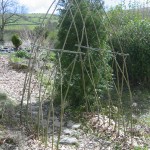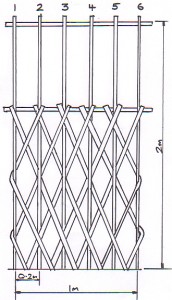 These instructions describe how to construct a living willow arch. The arch described is 1m (3’3”) long, 2m (6’5”) high and 1.5m (5’) wide. The arch walls bow out at the sides, a simple lattice is used that covers about two thirds of the walls and horizontal supporting rods are used at the top of the lattice and the arch itself. The arch pattern can be repeated as required to create a tunnel.
These instructions describe how to construct a living willow arch. The arch described is 1m (3’3”) long, 2m (6’5”) high and 1.5m (5’) wide. The arch walls bow out at the sides, a simple lattice is used that covers about two thirds of the walls and horizontal supporting rods are used at the top of the lattice and the arch itself. The arch pattern can be repeated as required to create a tunnel.
You can download these instructions as a Word Document or a PDF file.
Willow Required
- Fourteen 2.7m (9’) or longer rods for uprights, one top support and one spare
- Twenty six 2.1m (7’) or longer rods for lattice sides and horizontal binders plus spare
Tools and Extras
- 60cm (2’), 15mm (3/4”) metal rod – a large screwdriver will do
- Hammer to hammer in metal rod; claw, lump or sledge depending on how hard the ground is
- Gardening twine for tying the rods together. Cut about forty 40cm (1’ 6”) lengths of twine.
- Rubber ties – about forty 30cm (1’) lengths – can be used instead of twine as they expand with the growing willow, although they will still need removing in a few years.If rubber ties are used the twine can be used for temporary ties. Personally I prefer to just use twine.
- Sharp knife or scissors for cutting twine
- Secateurs and maybe loppers for thick rods
- Tape Measure
- Step ladders to get up and tie the uprights together
- Mulch mat and pegs or other mulching material, and possibly wood chip to cover the mulch
- Chalk to mark mulch mat if used
Instructions
1. Check you’ve got everything
Check you’ve got all the willow that you need and collect together everything you might need from the tools and extras list above.
2. Choose a location for the structure
Choose a location away from any shade, other plant roots and any kind of water pipes (as the willow will be attracted by the water and could grow into the pipes) or the foundations of a building (in clay soil the willow can dry out the ground with the possibly cause subsidence). As a guide the roots will grow about the same distance as the branches spread, so about 10m (30’).
3. Mark out base of the structure
To reduce competition from the grass the area where the structure is to be planted can be mown and covered with a mulch mat, or a suitable alternative: cardboard, old carpet, etc. The willow will still grow with no mulch mat but may take longer to establish.
The mat should be big enough such that the uprights are never closer than 50cm to the edge. For this arch that would mean a mulch mat 2m (6’5”) long and 2.5m (8’) wide. The mat should be pegged down 2cm (1”) from the edge every 25cm (1’) or the edge could be pushed into the ground with a spade.
Mark out the first side of the arch with twine and make five holes 25cm (10”) deep, 20cm (8”) apart and pointing out at an angle of about 45˚ (making the holes point outwards gives a nice curve to the willow and makes the arch wider). Mark out the second side 1.5m (5’) away and make a similar line of holes parallel to the first.
4. Create the Main Structure: Uprights, Binders and Top Support
Push each of the 2.7m (9’) rods fully into each hole (about 25cm or 10”) and rotate the rods so that opposite pairs bend toward each other. Using the twine temporarily tie the tops of the first and last pair of uprights and lay a 2.7m (9’) rod across the top. Adjust the two pairs to get the top support flat and at a suitable height (about 2m or 6’5”) and then temporarily tie together the rest of the uprights.
Bind the uprights by weaving one 2.1m rod through the uprights on one side of the arch about two thirds of the way up – the binders – and then weave another going the opposite way around the uprights. Repeat on the other side. If you want to get really clever weave the binders up and down as well as in and out!
Hammer the ground around each upright to close up the hole and remove any air pockets (if there is any air around the rod it won’t produce any roots at that point. Give each rod a gentle tug to test that it is held firmly.
5. Create lattice: Weavers
Make a 25cm (10”) deep hole at the centre of each pair of uprights. Make these holes big enough for two 2.1m (7’) weavers and angle them out at 45 degrees if that’s what you’ve done with the uprights.
 The weavers weave around the uprights, not each other (that just gets too confusing); the weavers should cross on the same side of an upright. They always start from outside the first upright (to ensure there are no rods to snag people on the inside of the arch), just below the binders, and you always start from the top. The angle they come in will determine how many uprights they cross and the height of the weave. In these instructions they are at about 60˚ and cross three uprights. Try to make sure you make no kinks in the rods as the willow may die past the kink.
The weavers weave around the uprights, not each other (that just gets too confusing); the weavers should cross on the same side of an upright. They always start from outside the first upright (to ensure there are no rods to snag people on the inside of the arch), just below the binders, and you always start from the top. The angle they come in will determine how many uprights they cross and the height of the weave. In these instructions they are at about 60˚ and cross three uprights. Try to make sure you make no kinks in the rods as the willow may die past the kink.
For this paragraph the uprights and holes are number left to right. Starting from the left end, just below the binder, weave a 2.1m (7’) rod outside the first upright, behind the second, in front of the third and then push it into the third hole along. Repeat this for the second and third weaver pushing it into the fourth and fifth weaver hole respectively. The fourth and fifth weavers will extend past the end of the arch so gently bend them back around the last upright and bring them back into the fifth and fourth weaver holes respectively (gently stroke the inside of the weaver to warm the fibres and make it easier to bend). Working back the other way and starting from outside the sixth upright, weave a rod in front, behind and in front of the uprights and into the third weaver hole. Repeat this for the next two weavers pushing into the second and first weaver holes respectively. Repeat this pattern for the next two weavers but bend them around the first upright and into the first and second weaver holes respectively. Repeat this pattern on the other side of the arch. It’ll be a lot clearer once you actually start doing it, just stand back and take a look at it often if you want to get it spot on!
Hammer the ground around each weaver to close up the hole and remove any air pockets. Gently tug the rod to ensure it is held firmly. Temporarily tie the points where the weavers cross the uprights.
6. Tidy up and complete
Stand back and admire your handy work. Ensure everything looks even and as it should, adjusting as necessary.
Replace the temporary ties with permanent ones, wrapping the ties twice and keeping them tight to improve the chance of a pressure graft. Having the knots on the outside of the arch will leave less to catch people on the inside of the arch. You can use rubber ties or garden twine for the permanent ties, although rubber ties will need to be checked once a year and removed once they start to cut into the rods. Gardening twine will naturally rot and drop off after a couple of years.
Tidy up by cutting the excess off the uprights about 10cm above the tie to give a neat cross (or excess can be weaved around the binders), do the same with excess horizontal binders, ties ends, etc.
7. Water
Give the base of the rods a good watering to help them get established and at regular intervals for the first year if it is at all dry weather. Give them a good soak once a week, rather than little and often to encourage the roots to go down rather than stay near the surface.
8. Mulch
If a mulch mat hasn’t been used, spread something around the base of the arch to suppress the grass will help the willow to establish although it isn’t essential: bark, wood chip, card board, etc.
9. Maintenance
Future maintenance can be a little or as much as you like, although if you just leave it the centre of the arch may die back the two sides open up. If you would like it to keep its shape prune in the winter or weave the new growth back into the structure and trim during the summer. Most of the growth will be from the top so weaving in the new growth will help fill out the side.
Rubber ties will need cutting off after two or three years once the poles have started to graft together but before they start impeding the growth.
Click here for more information on maintaining a living willow structure.
Notes – Other Info
Receiving the Willow
Once you receive the willow it should go into the ground as soon as possible. Failing that heel it into the ground until you need it (dig a shallow trench and insert the end of the willow into the trench with the rod lying over at an angle, then fill in the trench and firm the soil) or if the ground is frozen the willow can be kept in a cool, frost-free place. The willow should root as long as it is planted before April, but the sooner the better.
Composting
On poor soil (dry, sandy or rocky) a spade width trench can be dug for the willow to be inserted into and the soil mixed with compost. Just having the soil turned over can make it easier to insert the willow.
Credits
The weave used in the arch is the Universal Weave developed by Steve Pickup of The Willow Bank.